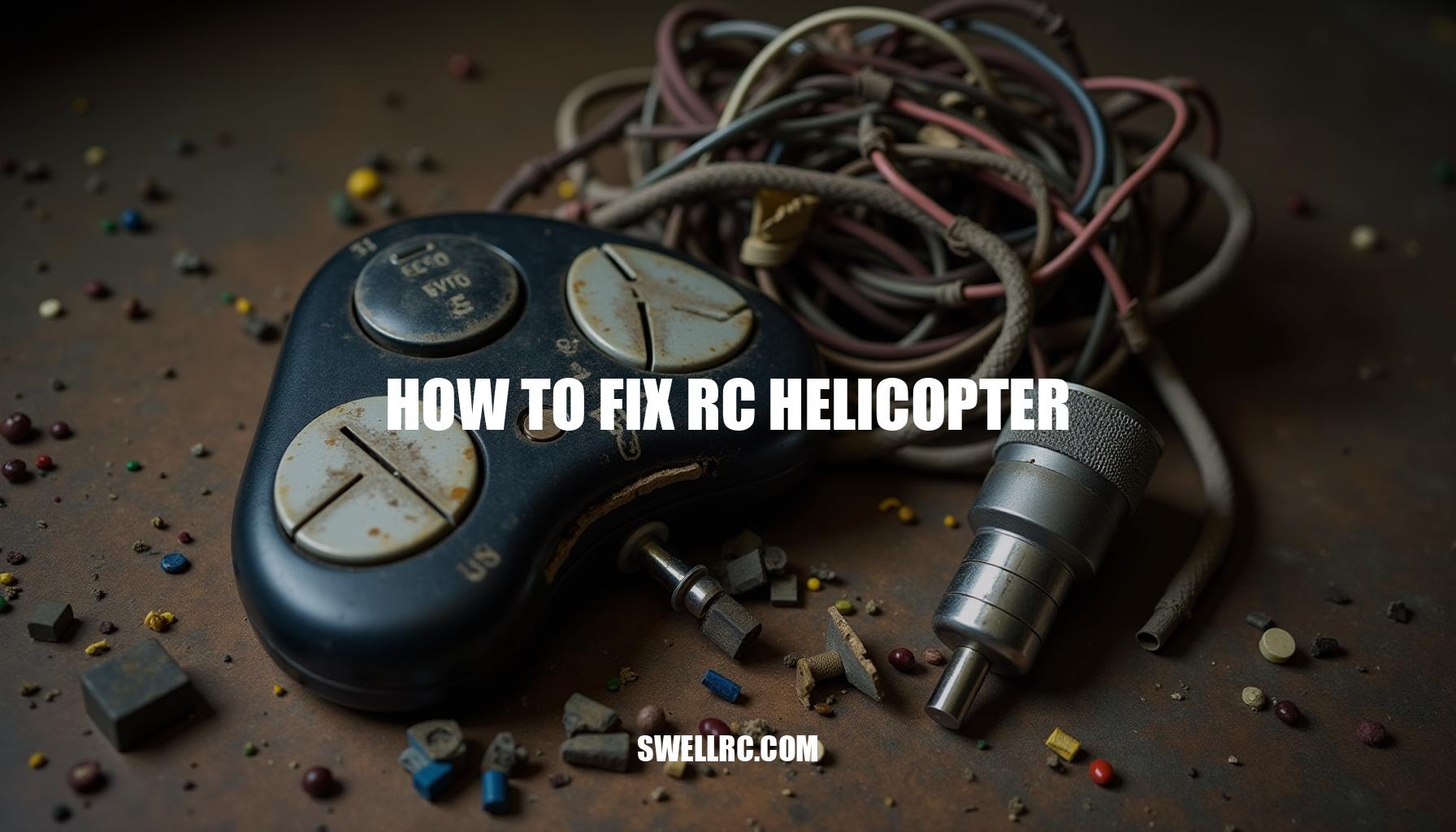How to Fix RC Helicopter: A Comprehensive Guide
The first time my little heli lifted cleanly off the driveway, I grinned like a kid. The first time it refused to arm after a gentle bump? I learned what every RC pilot eventually learns: flying is magic; fixing is the skill that keeps the magic going.
Over years of tinkering—burnt motors, mis-trimmed rotors, and a lot of trial and error—I built a simple, reliable approach to bring a remote-controlled helicopter back to life. In this guide, we’ll cover everything from quick battery checks to deeper repairs like motor swaps and light circuit work. We’ll keep it friendly, practical, and methodical—because most problems, like an RC helicopter not flying, have surprisingly simple causes when you test in the right order.
Whether you’re dealing with helicopter motor issues, helicopter balance problems, or other common remote-controlled helicopter troubleshooting challenges, mastering RC helicopter maintenance and RC helicopter repair will keep your flights smooth and enjoyable.
Section One — Common reasons your RC helicopter won’t fly
If your RC helicopter won’t take off, it’s important to systematically diagnose the root causes by starting with the symptoms and testing one suspected issue at a time. Here are the usual suspects you should consider:
- Power and battery issues
Symptoms include blinking lights, motor stuttering, and short flight times. This often stems from an undercharged or aged LiPo battery, a faulty charger, or poor battery contact.The quick test involves measuring voltage after charging, inspecting connectors, and trying a known-good battery pack.
- Signal and transmitter issues
If you notice no response to throttle, delayed inputs, or random beeps, transmitter issues may be the culprit. Common causes are not being bound to the receiver properly, TX/RX protocol mismatches, or trims and dual rates set incorrectly. To troubleshoot, re-bind according to the manual, reset trims to center, and check mode and throttle cut settings. - Rotor and blade alignment
When experiencing vibration, wobble, drifting, or tail yaw during hover, poor rotor calibration and blade alignment are likely.Look for bent main shafts, unbalanced blades, loose feathering shafts, or bad blade tracking. A simple test is to spin up the rotors on a smooth surface, observe blade tracking, and check grips and linkages for looseness.
- Motor and drivetrain wear
Symptoms like a motor that won’t spin, burning smells, or grinding noises indicate internal wear. Possible causes include stuck brushed motors, worn bearings, stripped main gears, or ESC faults.Test by spinning motors by hand, inspecting gears, and swapping motor leads to isolate whether the problem lies with the ESC or the motor.
- Structural or crash damage
Persistent tilt, tail spin, or lift loss following a crash might point to bent shafts or booms, cracked frames, warped blades, or misaligned swashplates. Conduct a careful visual inspection under good lighting and compare linkage lengths against your helicopter’s manual.
Using this checklist will guide you through battery troubleshooting, pinpoint transmitter issues, identify problems with blade alignment, and help ensure proper rotor calibration. For deeper insights, pairing these steps with a more comprehensive guide like this primer on why your RC helicopter won’t lift off can be invaluable in getting you back to smooth flying.
Quick reference — Common problems vs. fixes
When facing issues with your RC helicopter, effective RC helicopter troubleshooting is essential to get you back in the air quickly. Common problems and their solutions can be summarized in the following table:
| Problem | Likely Cause | Quick Fix |
|---|---|---|
| No lift | Low voltage or tired pack | Fully charge; test with a fresh battery; verify connectors |
| Spins but won’t take off | Reversed tail/gyro, uneven blade pitch | Recalibrate gyro; verify blade tracking and pitch links |
| Severe wobble | Unbalanced or bent blades/shaft | Replace or balance blades; inspect main shaft |
| No throttle response | Not bound or throttle cut enabled | Re-bind; disable throttle cut; center trims |
| One motor dead | Burned motor or ESC channel | Swap motor leads to confirm; replace failed part |
| Short flights | Old LiPo or over-geared setup | Check internal resistance; use appropriate gear/pinion and a healthy pack |
| Drifts constantly | Misleveled swash/gyro | Level swashplate; recalibrate gyro/accelerometer |
| Grinding noise | Stripped main/tail gear | Replace gears; re-check mesh and shaft straightness |
Many problems stem from battery fatigue, which is often overlooked, so always verify battery health before proceeding. Additionally, rotor misalignment is a common culprit behind severe wobbles or drifting, and careful inspection along with transmitter calibration can resolve these issues effectively. When dealing with motor failures, proper motor replacement guided by swapping leads helps diagnose if the issue lies with the motor or ESC.
Finally, consistent transmitter calibration ensures responsive control and prevents throttle or binding problems. Implementing these checks makes RC helicopter troubleshooting both efficient and successful.
Section Two — Step-by-step troubleshooting process
When tackling step-by-step RC helicopter repair, a systematic approach saves both time and spare parts. Begin with pre-checks and safety: remove blades for bench tests, confirm the throttle cut is on, and inspect for cracks, loose screws, and bent shafts. Next, focus on battery and power: fully charge the battery with a reliable charger, measure resting voltage to ensure balance on multi-cell packs, try a known-good battery, and check for warm connectors or frayed leads which can indicate power issues.
Third, address radio link and controls: re-bind your transmitter and confirm you’re using the correct model memory. Center trims and subtrims, verify the control mode (1 or 2), throttle range, and endpoints. For those encountering transmitter issues, a concise walkthrough can be found here.
If controls feel inconsistent, reviewing the fundamentals of helicopter RC remote control helps match your transmitter settings to the helicopter’s control system here.
Fourth, perform gyro and calibration: level the helicopter and carry out gyro/accelerometer calibration as per the manual. Confirm that the tail direction is correct and that gyro gain is appropriately set to avoid overcompensation. Next, inspect motors, gears, and shafts: spin motors by hand, examine main and tail gears for missing teeth, verify gear mesh, and if you have brushed motors that feel weak, compare RPMs between sides and replace components if necessary.
Sixth, check electronics and boards: look for burnt components, cold solder joints, and loose plugs. Building some knowledge of RC circuit boards goes a long way—refer to this primer here before attempting to reflow joints or reseat plugs. Then move on to blade tracking and pitch: ensure blade grips are matched, inspect the feathering shaft, and adjust link lengths so both blades track the same path at hovering RPM.
Finally, test hover and fine-tune: reinstall the blades and conduct a low hover test in a clear area. Make micro-adjustments to trims, gyro gain, and blade tracking. Throughout this process, remember these pro tips:
- Mark your baseline settings for reversibility of changes.
- If a crash preceded the issue, suspect bent shafts or slipped gears before electronics.
- If the heli won’t arm after binding, recalibrate throttle endpoints and ensure throttle is at zero on power-up.
By carefully following these ordered steps, incorporating battery troubleshooting and rotor calibration techniques, and addressing transmitter issues or receiver replacement as needed, you’ll diagnose and repair your RC helicopter efficiently and effectively.
Section Three — Model-specific troubleshooting insights
Different brands hide different quirks that require model-specific RC helicopter repair knowledge. For instance, the Revell Control RC Roxter is notorious for its binding sequence timing and gear mesh tolerance issues. To troubleshoot these effectively, it’s essential to confirm the bind order precisely and inspect the main gear after even minor crashes.
Detailed guidance on Revell Control troubleshooting can be found at Swell RC.
Similarly, the Sky Rover often exhibits drift due to factory gyro bias and connector fatigue from frequent battery swaps. Practical fixes include recalibrating the gyro on a perfectly level surface and gently re-tensioning or replacing worn connectors. For comprehensive Sky Rover troubleshooting steps, visit this guide.
Below is a mini-compare table that highlights frequent issues by model style, helping enthusiasts understand key rotor calibration differences and other factors that influence maintenance approaches:
| Model Type | Typical Issue | First Check |
|---|---|---|
| Fixed-pitch toy-class | No lift or constant spin | Battery health; tail motor polarity and gyro calibration |
| Entry hobby-class FP | Wobble/drift | Blade balance and swash leveling |
| Collective pitch | Twitchy tail or uneven pitch | Tail gain and pitch curves; feathering shaft straightness |
| Scale bodies | Overheating | Cooling airflow and gear drag under fairings |
Section Four — Advanced fixes and DIY enhancements
When basics aren’t enough, stepping up to precision work is essential for advanced RC helicopter maintenance. How to repair RC helicopter motor is a fundamental task that involves labeling connectors, matching KV/type ratings, and briefly bedding in brushed motors at low voltage. It’s also critical to check the gear mesh and apply thread locker to pinion and grub screws to prevent loosening during operation.
For receiver replacement or upgrade, ensure you match the protocol or use a compatible receiver and flight controller. This process requires re-binding the receiver, setting failsafe parameters, and recalibrating endpoints to guarantee precise responsiveness. When it comes to blade balancing and tracking, a simple blade balancer proves invaluable; adding small tape pieces to the lighter blade can perfect balance.
Always re-check blade tracking under hover RPM conditions to maintain smooth flight performance.
Transmitter recalibration is equally important. Creating a fresh model memory from scratch allows you to accurately set endpoints, dual rates, exponential curves, and throttle/pitch curves specifically for collective pitch (CP) helicopters. Verify throttle cut and hold functions meticulously to ensure safe operation.
For circuit rewiring, replace brittle leads and reflow dull solder joints. Applying heat-shrink tubing offers strain relief for connectors, boosting durability and reliability.
If you love to tinker, building your own airframe teaches comprehensive repair skills. Start with design and material inspiration from resources like how to make a RC helicopter. For those curious about creating a custom controller, this DIY remote overview is a fascinating rabbit hole.
Recommended bench gear includes:
- Precision screwdriver set, hex drivers, thread locker (non-permanent), calipers, and a blade balancer
- Digital multimeter and smoke stopper for thorough electronics checks
- Soldering iron with fine tip, rosin-core solder, flux, and heat-shrink tubing
The right tuning mindset transforms troubleshooting into engineering. By measuring, adjusting, and testing in incremental steps, logging changes, monitoring temperatures, and letting data guide upgrades, you can achieve superior RC helicopter performance and longevity.
Section Five — Preventive maintenance and flying best practices
Most failures in RC helicopter operation are easily preventable with a simple 10-minute preventive RC helicopter maintenance routine. Developing key habits such as battery care, fastener checks, cleanliness, regular calibration, and environmental awareness can significantly extend component lifespan and improve flight reliability. Consider these top 5 habits to keep your helicopter in peak condition:
- Battery care: Always store LiPo batteries at storage voltage, avoid flying below the safe cutoff, and label aging packs to monitor their health effectively.
- Fastener check: Inspect critical parts like blade grips, feathering and main shafts, landing skids, and gear mesh every few flights to avoid unexpected failures.
- Clean and cool: Remove dust from motors and gears regularly, and ensure proper airflow, especially under scale canopies, to prevent overheating.
- Calibrate regularly: After any hard landing, re-level the swash plate and perform gyro calibration to maintain flight stability and control precision.
- Environment matters: Avoid flying small FP helicopters in high winds and skip flights during extreme heat or cold, as environmental factors greatly affect performance and safety.
For inspiration in enhancing reliability, study how robust scale designs manage weight distribution, airflow, and balance.
A prime example is the UH-60 Blackhawk RC helicopter, which demonstrates these principles effectively. Learn more about its design here: https://www.swellrc.com/uh-60-blackhawk-rc/.
Maintenance intervals vs. typical lifespan (quick guide)
Maintaining an RC helicopter maintenance schedule is crucial to ensure optimal performance and extend the component lifespan. Regular inspections and timely replacements of parts allow for smooth operation and safety during flights. Below is a detailed overview of recommended check intervals and typical lifespans for key components, which also include considerations for battery longevity and rotor system care:
| Component | Check Interval | Typical Lifespan (with care) |
|---|---|---|
| Main blades | Every 3–5 flights | Dozens of flights; replace if warped or cracked. |
| Main/tail gears | Every 5 flights | 30–100 flights; replace at first sign of wear or noise. |
| Brushed motors | Every 10 flights | 20–80 flights; shorter lifespan if operating hot or in dusty conditions. |
| Brushless motors | Every 20 flights | 100–500+ flights; listen for bearing noise as an indicator. |
| LiPo battery | Every flight (voltage/IR check) | 100–300 cycles; retire immediately if battery becomes puffy or internal resistance (IR) is high. |
| Linkages/ball ends | Every 10 flights | 50–200 flights; replace when movement becomes sloppy to maintain precise control. |
| Screws/loctite | Every 5–10 flights | Re-apply thread locker after any major service to ensure secure fittings. |
| Gyro calibration | After bumps or when trims drift | On demand; always recalibrate as a baseline after repairs or crashes. |
By adhering to this comprehensive maintenance routine, hobbyists can significantly enhance their RC helicopter’s reliability and longevity. Prioritizing rotor system care and monitoring battery health through consistent battery longevity checks ensures flights are safe and enjoyable every time.
Conclusion — The reward of mastering RC helicopter repair
Fixing an RC helicopter is both a science and an art that nurtures RC helicopter repair confidence through patient troubleshooting and practical maintenance. You’ve learned key skills such as diagnosing power, signal, and rotor issues, binding and calibrating controls, replacing motors, reflowing simple joints, and implementing strategies to prevent recurring problems.
To master this craft, follow these essential steps:
- Be patient and methodical, changing one thing at a time to isolate issues effectively.
- Keep detailed notes on your repairs and adjustments to build a knowledge base for future reference.
- Regularly perform practical maintenance to extend the life and performance of your helicopter.
After countless hours of tinkering, when the blades finally spin smoothly and the helicopter lifts into a steady hover, you experience the true joy of hobby craftsmanship. Keep exploring new techniques, share your findings with the community, and savor every moment of your journey from troubleshooting challenges to expert mastery.
Frequently Asked Questions
- Why is my RC helicopter not flying or lifting off?
Most no-lift cases come down to power or pitch. Confirm a fully charged, healthy battery; re-bind and verify throttle endpoints; recalibrate gyro; check blade tracking and pitch linkages; and inspect for a bent main shaft or stripped main gear. - How do I calibrate my RC helicopter blades?
Balance each blade on a balancer, add small tape to the lighter blade, then verify tracking: at low hover, both blades should follow the same path. Adjust linkage length or feathering shaft shims until the tracks overlap cleanly. - What should I do if my RC helicopter’s motor stops working?
Spin it by hand to feel for binding, inspect gears, and swap motor leads to see if the problem follows the motor or stays with the ESC channel. If the motor is the culprit, replace it and re-check gear mesh and alignment. - How do I connect an RC helicopter to its remote again?
Re-bind per the model’s sequence: throttle at zero, correct model memory, hold bind button or use bind plug, power on heli, then TX. After binding, recalibrate throttle endpoints and verify failsafe. A step-by-step help: https://www.swellrc.com/how-to-connect-rc-helicopter-to-remote/. - Can I fix my RC helicopter at home without professional help?
Yes. Most fixes—battery, binding, blade tracking, basic solder joints, gear replacements—are beginner-friendly with a screwdriver set, a multimeter, and patience. Work methodically and change one variable at a time. - Why does my RC helicopter spin but not take off?
A constant spin suggests gyro direction or tail authority problems; no lift points to pitch or power. Recalibrate gyro on a level surface, verify tail motor polarity/ESC mapping, confirm correct blade orientation, and check for a bent main shaft.



